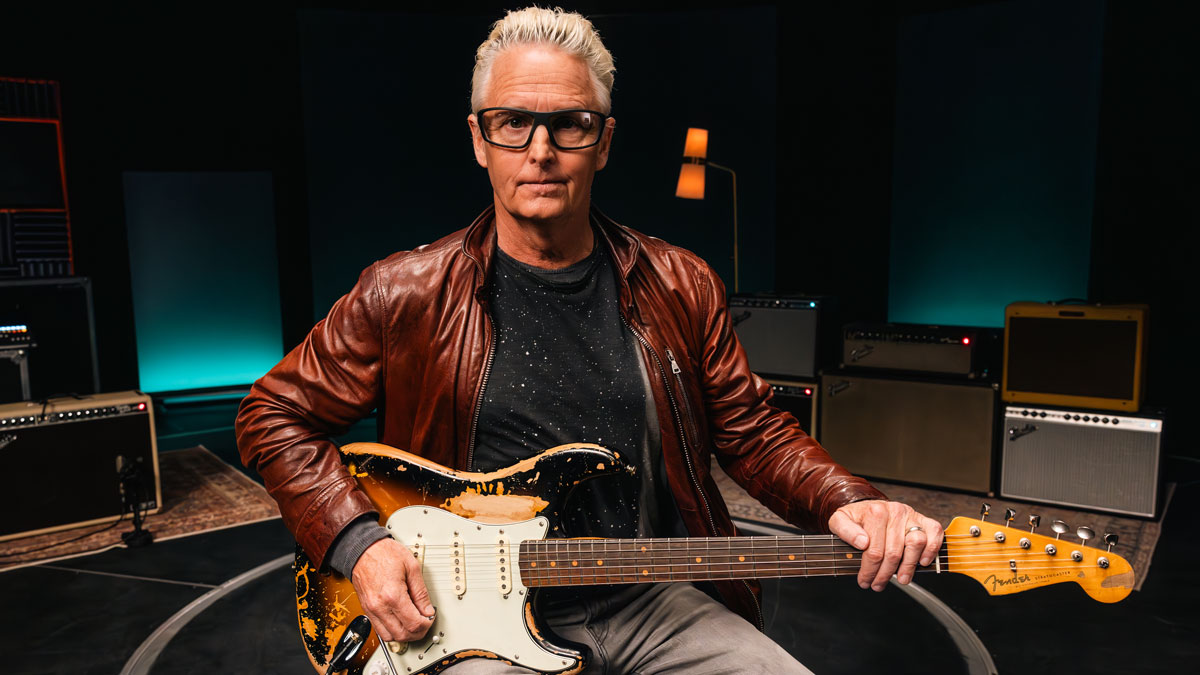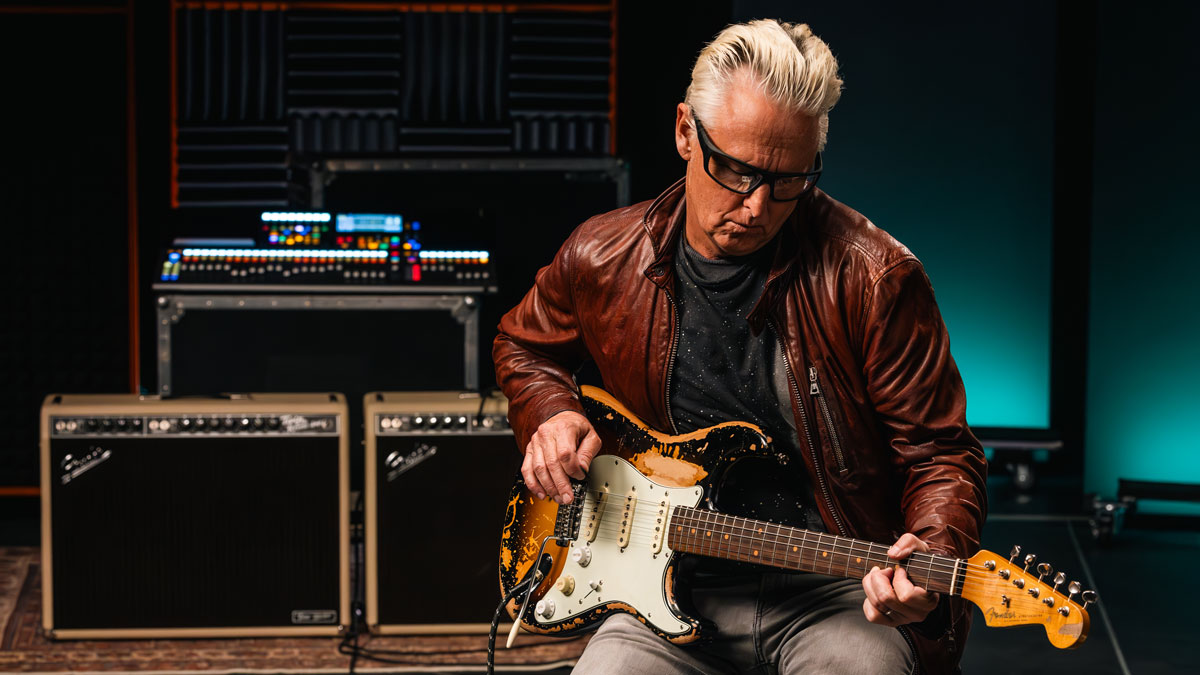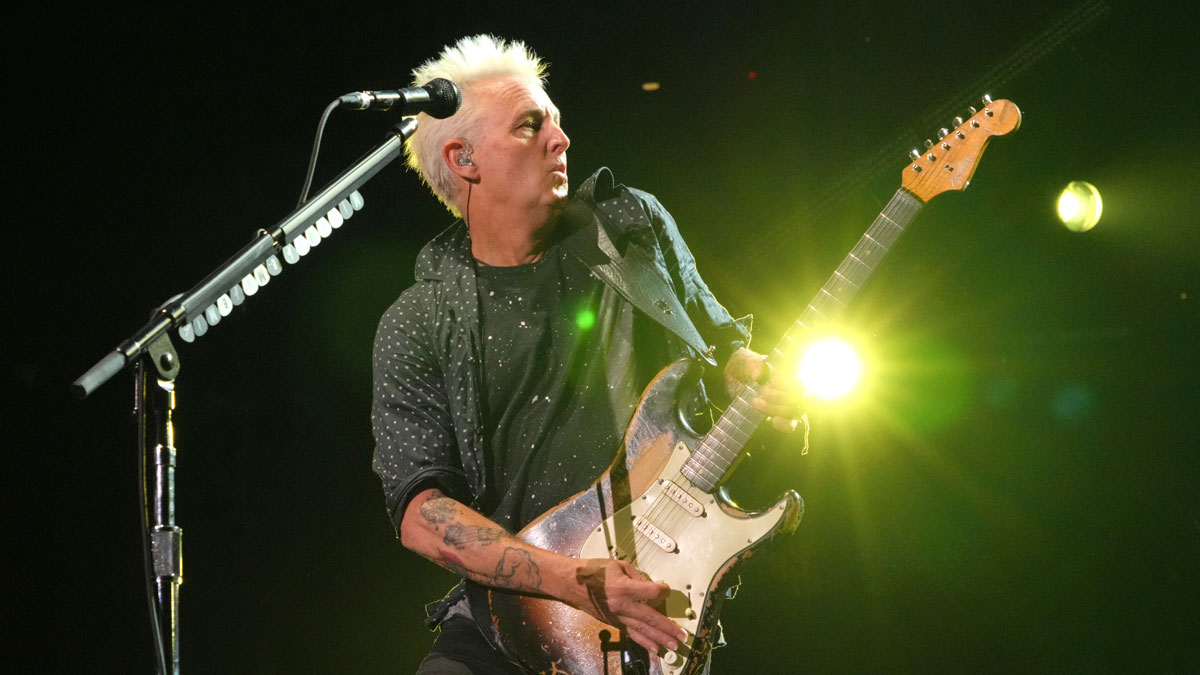“My original ’60 Stratocaster will always sound the best. This one is right next to the best”: Pearl Jam’s Mike McCready on why he’s playing his more affordable signature guitar live, covering Eruption and embracing digital amps
Now onto his second signature Fender, grunge’s answer to Stevie Ray Vaughan reflects on his greatest Stratocaster moment, how Eddie Van Halen and Chris Cornell inspired his guitar playing, and why you should be excited for the next Pearl Jam album – oh, and his rock opera about the Seattle scene

Of all the guitarists to emerge from the Seattle fog in the early ’90s, Mike McCready is perhaps the closest thing the scene had to a ‘conventional’ guitar hero. Inspired by everyone from Kiss to Stevie Ray Vaughan and Van Halen, his chops combined blues feel with just a dash of hair-metal flair from the outset.
But it wasn’t just his playing that positioned McCready firmly in the guitar hero camp. Pearl Jam’s meteoric rise to fame allowed the guitarist to live his gear fantasies, too. Shortly after the unprecedented success of debut album Ten, McCready was able to invest in his ultimate prize: a Fender Stratocaster, built in 1959… or so he thought.
In 2021, Fender built a Custom Shop replica of McCready’s Stratocaster, with all the wear and tear inflicted by the guitarist over three decades of touring with Pearl Jam – not least the epic headstock chip inflicted while performing with Neil Young in the ’90s.
But during Fender’s examination of the guitar, Master Builder Vincent Van Trigt discovered the Stratocaster was actually built in 1960, rather than 1959 – news that came as something of a surprise to McCready, who also owns a ’59 Les Paul.
“Thinking that guitar was 1959 for almost 30 years was very much of a shock,” he tells Guitar World from his hotel room in Texas, where Pearl Jam are due to perform the following night. “And I’ve got a ’59 tattoo, so I’ll have to get that changed to a ’+1’!”
With the original run of 60 guitars long since sold – at $15,000 a pop, no less – Fender has seen fit to launch a considerably more attainable version for fans seeking the Pearl Jam icon’s snappy single-coil tone and his Strat’s innumerous battle scars.
The new made-in-Mexico Mike McCready Stratocaster isn’t hand-made by Van Trigt like the original, but it does capture the style and substance of the Custom Shop version for a snip under $2,000. McCready did try to get the $1,899 price tag lower, but the increase in material and shipping costs over Covid meant it was impossible to achieve. But, as the guitarist notes of his latest guitars, “They’re cheaper – not in terms of quality but in terms of price.”
Get The Pick Newsletter
All the latest guitar news, interviews, lessons, reviews, deals and more, direct to your inbox!
Although the band have opened up in recent years, interviews with members of Pearl Jam are still few and far between. But if there is any topic that will get Mike McCready talking, it’s guitars.
With a tight 20-minute slot under the watchful eye of Fender, we sought to dig into as many of the big talking points as we could: the switch to digital amps, those Eruption covers, his greatest Strat moment.
But it wasn’t until we asked about Chris Cornell’s influence on his guitar playing that we got more than we bargained for. Suffice to say, McCready has big plans for the future, and they’re not just with Pearl Jam – although the Seattle veterans’ new album is also shaping up to be one of their most vital in the hands of Ozzy Osbourne and Iggy Pop super-producer Andrew Watt.

Congratulations on your new signature Stratocaster! How does the new model compare with the previous Custom Shop version?
“They play great. I’ve just started playing it on the tour. So I’ve used it on Indifference, I’ve used it on Daughter. I’ve used it on Porch once, I’ve used it on a bunch of our songs. Because I knew I was going to talk to you, I wanted to make sure I was playing this thing that I’m endorsing right now. I want to make sure it’s a legitimately great guitar, and Fender did a fantastic job of it, but I gotta play it live to make sure before talking to you about it. And it plays and sounds like my original one. You know, my original one is the best and that will always sound the best. This one is right next to the best.”
Were you road-testing models prior to the release of this guitar?
The first time I ever played my 1960 Stratocaster was on Going Down with Keith Richards when we opened up for him on New Year’s Eve 1992. That was a dream
“I was. I was working with [Head of Signature Artists] Michael Schultz and Fender and their team, and [Pearl Jam equipment manager] George Webb on our side. On the last European tour, we had a bunch of these models come out and we tweaked things – maybe the pickups sounded too high-endy at one time and then we got that fixed. Some of the colors were maybe not [right].
“You had a lot of back and forth, but dealing with Fender was relatively quick and easy. They’re very good at sending me stuff, so they’d send me different models. And what eventually happened was, I took two models and put them together: the neck of one, the body of another they were working on, and that’s the one that we have now. But I did play it on the European tour last year.”
What do you consider to be your finest recorded moment with your original Strat?
“Oh my gosh, that’s a good question. I’ve played it on almost every single record. I didn’t play it on [Temple of the Dog epic] Reach Down – I love that thing, but that’s not with that guitar. I would say Daughter is one of the finer ones. I used it on In My Tree in the studio – that’s cool. That’s a really hard question because it’s been on so many songs. Let me get back to you on that. I’ll remember. [pause] Oh, Nothing as It Seems.”
I was going to bring that up if you didn’t mention it, because that is a fantastic solo.
“Thank you for suggesting it. That solo was some dark times for me when I went through that thing. I was using some sort of a Fender pedal that they made in the ’60s – I forget what it’s called [most likely a Fender Blender – Ed]. I’ve only been able to get that sound on that song – I’ve never been able to get it live. I think it was because Tchad Blake, our producer, was helping with it.”
Great pick. Now that you know your Strat is a 1960 model rather than a 1959, have you been looking to buy a real ’59?
“[Laughs] The ’60 neck is thinner than a ’59, and I should have known that playing other ’59s over the years, but I never put the things together. I might get an original one someday, but I’m kind of good on guitars right now, so I have to slow down on that!
“Originally the reason I wanted to get a 1959 was because I love Stevie Ray Vaughan. I’m actually in Texas right now, where he was from, and he played a 1959. And maybe it was a ’59 with a ’60 body, I can’t remember. [Editor’s note: Although Vaughan often claimed he played a ’59, it was actually a ’63 body, ’62 neck and ’59 pickups, according to his tech René Martinez – so McCready’s ’60 Strat may feel closer to SRV’s than he first thought.]
“But I love that 1960, now that that’s what it is. I’ve played it more than any other guitar, in the history of [the band]. The first time I ever played it was on a song called Going Down with Keith Richards when we opened up for him on New Year’s Eve 1992. So that was a dream.”
Have other players played your Fender model and offered their opinions on it?
“I sent Annie Clark of St. Vincent the more spendy model, and she seems to really like it a lot. She’s been recording with it, which is a great honor for me. She’s a good friend of mine. She has her [Ernie Ball Music Man] guitar that she plays all the time, but she took the time to play this one, so I’m happy that she likes it. I haven’t given the new model to anybody yet, but I’ll be getting them out there for sure.”
It looked like Stone was playing one of your models live for a bit.
“Stone has my model of the more expensive one and he loves it. He plays it a whole bunch – on this tour, actually.”
You bring a wide array of instruments with you on tour, but you often switch up which guitar you use for specific songs – you’ve played Alive on Strats, Les Pauls and even Flying Vs, for example. What prompts that decision each night?
“It’s the immediacy of how I’m feeling. I’ll talk with my tech about a half-hour before the show, and we’ll go through the list and go, ’Okay, Strat here, Les Paul here, Strat here, tuned-down Les Paul here.’ There’s a lot of intricacies that go on with Pearl Jam now, because we have so many songs, and we tune some of them down, and they’re in weird tunings.
“I just have to say I’m feeling more of a Les Paul moment, or I’m feeling more of a Strat moment. I’ll make a quick decision. I’ll change what I wrote the hour before. Usually I’ll stick to what we do, but sometimes I feel like, ’Ah, I wanna just try something different.’ Just to throw myself a curve a little bit.”
Is that a tough gig for your tech?
“Probably a little bit, but I don’t do that that much – we usually work out a good thing because we want to have the set as tight as possible. So usually I stick to what I’m doing. Sometimes I’ll mix it up.”
You’ve also been spotted playing Fender’s digital Tone Master amps over the past year or so – what prompted the switch?
“My inclination is to always go tube amps, but these Fender digital amps, back to back against tube amps, sound exactly like tube amps. They’re phenomenal. They’re some of the best amps I’ve ever played. And they’re consistent in that, and maybe that’s the digital part of it.
“Again, I’m all about ‘not digital’; I love tube stuff. But our crew and everyone and myself, we’d A/B’d them back and forth with regular Fenders and Twins and things like that, and they were identical. So it made sense to play the newer ones, just in terms of going on the road and making sure they don’t fall apart or whatever.
“They’re fantastic. They break up really well, I can get a great punk sound out of them if I need to or I can get a good clean sound. It seems to be able to handle whatever I throw it in terms of wah pedal or a delay or whatever I use in there – octaver or something, they work cool. And Phase 90s work cool through them, so I love ’em. I’m sold.”

You’ve paid tribute to Eddie Van Halen on tour by covering Eruption. It’s perhaps the ultimate lead guitar showcase, so what inspired you to perform that song – and what did Eddie mean to you?
“Eddie Van Halen to me was a huge deal. I started playing when I was 12 years old and that’s right when his first record came out, and it was unlike anything I had ever heard.
“I heard Hendrix and he always was my hero and still is to this day, and then Eddie was another version of a guitar hero that felt like he came from outer space or something. Like, ’What is this? What is this Eruption thing?’
I’m almost there. I’m still struggling with a few parts of it. You know, I’ll never truly get Eruption. But it’s a masterpiece to try to do, so I want to do it the best I can
“You know, I’m just starting to play Smoke on the Water [at that time]. And I’m very young – I’d just started playing in bands when I was 12. So, when Eddie came out, he blew everybody’s mind. I always thought that this was something that was completely out of reach, that I would never be able to do Eruption.
“And thank God for YouTube, because there’s guys that have picked out every single note. Other people figured it out for me, so I didn’t have to try to figure it out. And I just made myself [go]: ’Okay, I’m gonna do this.’ This is my test to myself to see if I can actually do it.
“And I’m almost there. I’m still struggling with a few parts of it. You know, I’ll never truly get it. But it’s a masterpiece to try to do, so I want to do it the best I can.
“Oh man, I love him. I saw him four times live with David Lee Roth back in the day and it was unreal, seeing him live.”
How’s the new Pearl Jam record coming along, and what’s Andrew Watt bringing to the table?
“It’s just about finished. I think there’s a few tweaks here and there that have to happen and we’re probably not going to have anything out this year. But Andrew Watt brought an energy and a youthfulness and a great ear to us that I think we needed.
“He kicked us in our asses a little bit. Like, ’Okay, let’s go, let’s go, let’s go, let’s go go go!’ He’s the most hyper guy I’ve ever met besides myself. But he’s a giant fan of our band, and he’s a really great guitar player himself. He’s more known for the pop world in terms of his stuff. But he’s a really smoking guitar player in his own right.
Andrew Watt got us into a room and just pushed us as hard as we could be pushed
“Andrew Watt got us into a room and just pushed us as hard as we could be pushed. You know, it’s hard for a quote-unquote outsider to come into our world because we’ve done things a certain way. We’re open to new things, but we are also in our own world. We’ve done things for 30 years, so we know the dynamics of our band very well. But sometimes we need to get pushed and questioned, and Andrew did a great job of that.”
Andrew Watt has a serious guitar collection. Did you use any of his gear?
“He had a ’59 Strat that I played while we were in the studio. We used all of his equipment, which is different for us, too. I think Matt used his own drums, but I just went, ’Hey man, this guy’s got great equipment, and I’m just gonna play on whatever he says.’”
Is there any era of Pearl Jam’s career you can compare the new music to?
“It’s hard to do that. I hate trying to describe music. But there’s elements of the first three records in the energy that is there, but not things derivative of it. Also, Matt Cameron’s playing better than I’ve ever heard him in a long time. I mean, of course I’ve heard him with Soundgarden, and of course he’s incredible and always has been. But he’s playing more like that now – he’s kinda loose. Andrew pushed him to play however he wanted to play. How Matt’s playing on this record has made it amazing in my mind.”
A post shared by Mike McCready (@mikemccreadypj)
A photo posted by on
Speaking of Soundgarden, you recently shared a performance of a new original song, Crying Moon, in tribute to Chris Cornell. What did you take from Chris as a guitarist and musician?
“Chris is someone who I think about every day, and I’m still in loss and sad, but proud that I got to know him at one time. I look at it in a very sentimental way that he allowed me to play on that Temple of the Dog record – it was my first big thing I was ever part of, and it was a dream come true. And I’ll always love him for that.
“He didn’t have to let me play on that record – they could have done anything. We were talking about Reach Down earlier, and he was very encouraging, like, ’Hey, just go crazy and solo.’ I was very nervous and didn’t want to do that, and when he encouraged me to do that, to go crazy, I went for it.
I would go to Soundgarden rehearsals and I’d bring them pizza just so I could watch them rehearse
“And of course, I look at him as one of the greatest singers and songwriters of all time, aside from being a friend. So I look at him as a fan, too – I would go to Soundgarden rehearsals and I’d bring them pizza just so I could watch them rehearse. I really did! I was kind of their fanboy. So I probably irritated them a lot, I’m sure.
“I love Chris. I’m working on a little project about the Seattle scene and a musical rock opera thing. He’s part of it. [Crying Moon] is one of the songs that’s maybe going to be part of it, just an acoustic version of it.”
That’s a serious undertaking. Is there anything else you can reveal about that project at this time?
“I can’t right now because I’m just in the middle of it. I’m working on a script and I’ve got about 18 songs that I’m working on, and I’m singing on it. It’s been a long journey.
Is that a record or something for the theater?
“I hope so. A record and maybe some sort of stage/play thing, I’m not sure. It’s just from my experience in the Seattle music scene.”
Who are the new guitarists inspiring you today?
“There’s a band called Thunderpussy – I love Whitney Petty, the guitar player. She’s really phenomenal and new and exciting. I love Annie Clark. She has a few records out, obviously, but she’s got an interesting angular feeling to her playing I like a lot.
“Also, Jessica Dobson from Deep Sea Diver who’s out with us right now. She’s got a really cool style of delay, and she was showing me her pedalboard. She has a great voice to go along with it.
“Those three are the top three that come to mind right now. I’m stuck in the ’80s and ’70s – you have to drag me out!”
- For more information on the Mike McCready Stratocaster, head to Fender.com.

Mike is Editor-in-Chief of GuitarWorld.com, in addition to being an offset fiend and recovering pedal addict. He has a master's degree in journalism from Cardiff University, and over a decade's experience writing and editing for guitar publications including MusicRadar, Total Guitar and Guitarist, as well as 20 years of recording and live experience in original and function bands. During his career, he has interviewed the likes of John Frusciante, Chris Cornell, Tom Morello, Matt Bellamy, Kirk Hammett, Jerry Cantrell, Joe Satriani, Tom DeLonge, Ed O'Brien, Polyphia, Tosin Abasi, Yvette Young and many more. In his free time, you'll find him making progressive instrumental rock under the nom de plume Maebe.
“Even the thought that Clapton might have seen a few seconds of my video feels surreal. But I’m truly honored”: Eric Clapton names Japanese neo-soul guitarist as one to watch
“You better be ready to prove it’s something you can do”: Giacomo Turra got exposed – but real guitar virtuosos are being wrongly accused of fakery, too















